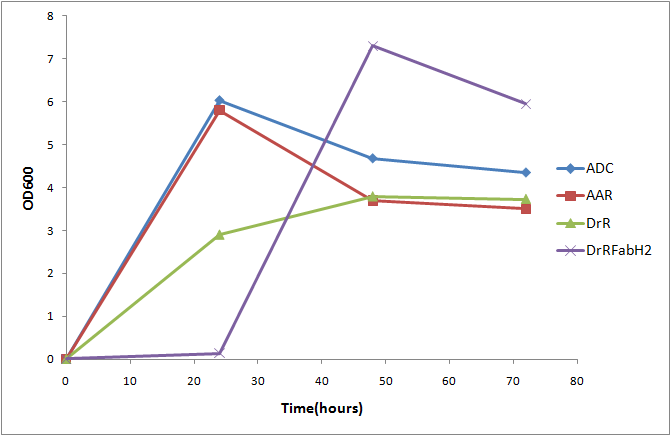Team:Washington/Alkanes/Future/FabH2
From 2011.igem.org
Branched Chain Alkane Production
Contents |
Background
The basic alkane production system is incapable of making branched chain alkanes, as E. coli normally only makes straight chain fatty acids. We thought that if we could engineer alkane producing E. coli that also makes alkanes, we could make branched chain alkanes, a significant porportion of diesel(reference). One protein whose expression has been previously shown (reference) to cause E. coli to produce branched chain fatty acids is FabH2 from Bacillus subtilis. The FabH family of proteins initiates fatty acid elongation by converting an Acyl-CoA into an Acyl-ACP, with is extended by 2 carbon units to form longer chain length fatty acids. Normally, FabH proteins use a simple 2-carbon acetyl-CoA to start fatty acid biosynthesis, resulting in linear fatty acids. However, FabH2 can also use Isobutyryl-CoA, Isovaleryl-CoA, and 2-Methylbutyryl-CoA( products from Valine, Leucine, and Isoleucine degredation)(include images), resulting in 2-methyl branched fatty acid production. If we could use FabH2 and the Petrobrick to get E. coli to produce both alkanes and branched chain fatty acids, we should theoretically be able to produce 2-methyl branched fatty-acids.
Methods
Fill me in!
Current Results
Thorout our experiments, we observed that cells expressing FabH2 grew significantly slower than any of our other alkane producing cells. In order to quantify this effect, we measured OD600 for alkane production constructs every 24 hours for a 72 hour period, producing a growth curve.

After 24 hours, FabH2 producing cells had barely grown at all, indicating a severe growth deficiency. The cells were able to rapidly grow after 24 hours, presumably due to a mutation that counteracted the nergative effects of FabH2. This toxicity is presumably due to the production of branched chain fatty acids. When branched chain fatty acids are incorporated into the cellular membrane, they would presumably have a negative effect on cell wall integrety by causing gaps in the phosphlipid bilayer. The growth deficiency of Fabh2 producing cells suggests that FabH2 is producing branched chain fatty acids.
Parts Submitted
Fill me in!
 "
"